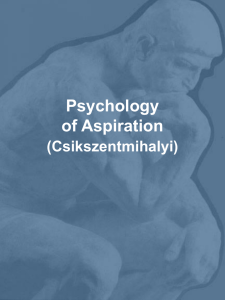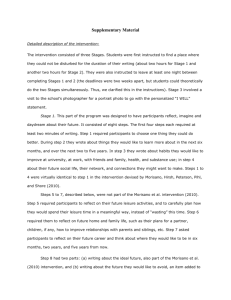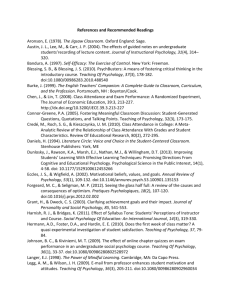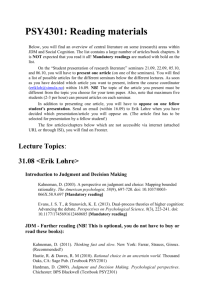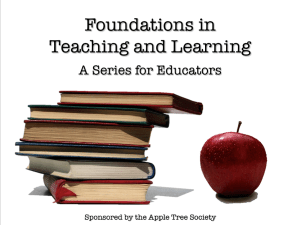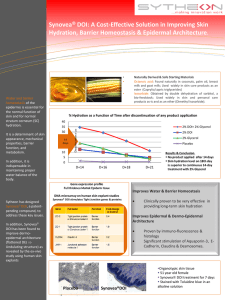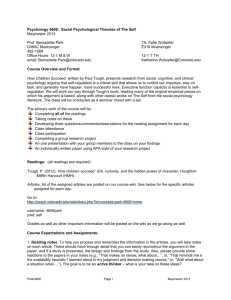The Force Is Your Ally - Southeastern Louisiana University
advertisement
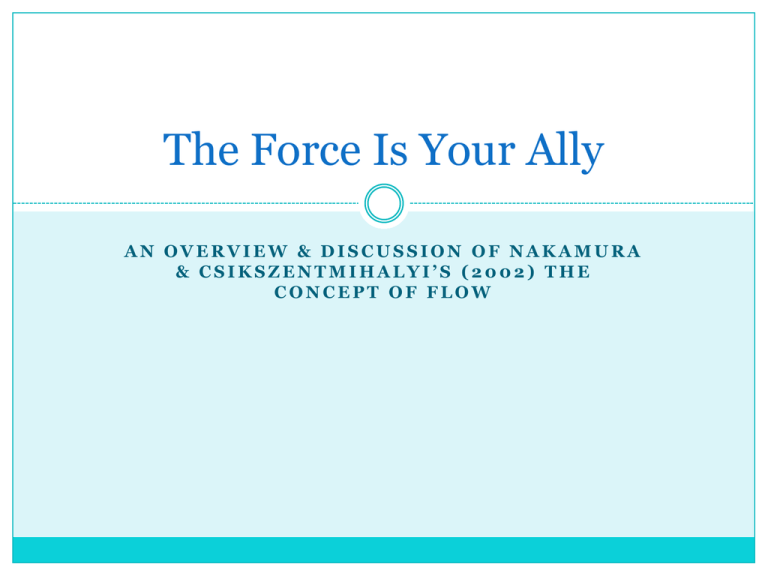
The Force Is Your Ally AN OVERVIEW & DISCUSSION OF NAKAMURA & CSIKSZENTMIHALYI’S (2002) THE CONCEPT OF FLOW Introduction Positive Psychology Interested in what constitutes and promotes human flourishing Csikszentmihalyi studied artists’/experts’ reports of experiences of intense involvement in and enjoyment of their chosen activity/profession Created the concept of “flow” “… a good life is one that is characterized by complete absorption in what one does” (p. 89) What’s Needed To Enter The State Of Flow? A challenging task that pushes, but does not exceed the individual’s abilities Delicate balance Not challenging= boredom Too challenging= anxiety A clear goal with frequent feedback Focused concentration on and attention to the task at hand “…attention becomes completely absorbed into the stimulus field defined by the activity” (p. 92) What Characterizes The State Of Flow? An intense and focused concentration on what one is doing in the present moment A merging of action and awareness A loss of reflective self-consciousness A strong sense of competence and control “In the zone” An altered experiencing of the passage of time It’s just fun “The motivation to persist in or return to the activity arises out of the experience itself” (p. 92) The Self Comprised of our sense of awareness, and our awareness of ourselves Both play a vital role in achieving and maintaining the state of flow “In our terms, these two aspect of the self reflect (a) the sum of one’s conscious processes and (b) the information about oneself that enters awareness when one becomes the object of one’s own attention” (p. 91) The state of flow is difficult to achieve and maintain, and easily disrupted A Fun Example http://www.youtube.com/watch?v=7YkbgvRMpW0&f eature=related “That Is Why You Fail” Luke lost his connection to the Force (state of flow) because he lost his focus, and doubted his abilities (lack of concentration & negative self-assessment) Basically, he got in his own way The Autotelic Individual While everyone has the capacity to enter the state of flow, for some it is easier than others The autotelic individual Is generally curious and interested in life Is persistent Is low in self-centeredness Able to find tasks enjoyable and rewarding on their own Challenging and supportive environments seem foster the development of these characteristics The Autotelic Individual Cont’d Neuroticism has been found to be negatively related to proneness to achieving the state of flow (Ullen, de Manzano, Almeida, Magnusson, Pedersen, Nakamura, Csikszentmihalyi & Madison, 2012) Conscientiousness has been found to be positively related to proneness to achieving the state of flow (Ullen et al., 2012) “a salient feature of neuroticism is emotional and cognitive state instability… Such fluctuations… could conceivably affect both cognitive and emotional aspects of flow, causing an increased risk for attentional lapses and a reduced sense of control and skill” (Ullen et al., 2012, p. 170) “Highly conscientious individuals are presumably more likely to spend enough time on deliberate practice to master more challening tasks” (Ullen, et al., 2012, p. 171) No relationship was found between proneness to achieving flow states and overall intelligence (Ullen, et al., 2012) How The Flow State Is Researched Interviews Questionnaires Experience Sampling Method Pagers/PDAs Physiological measures Creative thinking may be facilitated by reduced D2 receptors in the thalamus (de Manzano, Cervenka, Karabanov, Farde & Ullen, 2010) The ultimate goal of research in this area is to promote human wellbeing Research has been conducted in workplaces, educational settings, and many others Some Evolutionary Hypotheses Experiencing flow states may have facilitated positive affect and life satisfaction (Shoo & Sahu, 2009) as well as the development of a sense of purpose and meaning in life (Hicks & King, 2009; Kashdan & McKnight, 2009) Experiencing flow states with others has been found to be more enjoyable via “emotional contagion” (Walker, 2010) and to facilitate relationships via feelings of self-expansion (Graham, 2009) As a component of self-actualization, the ability to enter flow states may have been selected for by facilitating mate acquisition and retention (Kenrick, Griskevicius, Neuberg & Schaller, 2010) Rituals and their required focused attention may have facilitated group bonding via synchrony and the achievement of flow states (Rossano, 2010) Multilevel selection favored cohesive human groups (Richerson & Boyd, 2005) Back To The Mountain The harsh conditions and circumstances experienced by the Andes survivors met the contextual requirements for experiencing flow states Focus and concentration devoted survival The Andes survivors likely entered states of flow during their nightly ritual of reciting the rosary and during moments of intense appreciation for the beauty of their surroundings These moments of flow facilitated their bonding and subsequently contributed to their survival Back To The Mountain Cont’d “I forgot myself in the intensity of my concentration. … for a while I felt as if everything I had ever been had disappeared, and that I was now nothing more than the pure will to climb. … I had never felt so focused, so driven, so fiercely alive. For those astonishing moments, my suffering was over, my life had become pure flow.” (Parrado, 2006, p. 197) ? Can you think of another adaptive function(s) for flow states? Have you ever experienced a flow state? Do you think situations/contexts we associate with greater meaning are more conducive to flow states? Back To Dagobah! The take-home message: http://www.youtube.com/watch?v=QSN5TPKMJ24 Just for fun (outtro): http://www.youtube.com/watch?v=GITb6rzpTWM References de Manzano, O., Cervenka, S., Karabanov, A., Farde, L. & Ullen, F. (2010). Thinking outside a less intact box: thalamic dopamine D2 receptor densities are negatively related to psychometric creativity in health individuals. PLOS ONE, 5(5), 1-6. doi: 10.1371/journal.pone.0010670 Graham, J. M. (2008). Self-expansion and flow in couples’ momentary experiences: an experience sampling study. Journal Of Personality And Social Psychology, 95(3), 679-694. doi: 10.1037/0022-3514.95.3.679 Hicks, J. A. & King, L. A. (2009) Meaning in life as a subjective judgment and lived experience. Social And Personality Psychology Compass, 638-653. doi: 10.1111/j.1751-9004.2009.00193.x Kashdan, T. B. & McKnight, P. E. (2009). Origins of purpose in life: refining our understanding of a life well lived. Psychological Topics, 2, 303-316. References Cont’d Kenrick, D. T., Griskevicius, V., Neurberg, S. L. & Schaller, M. (2010). Renovating the pyramid of needs: contemporary extensions built upon ancient foundations. Perspectives On Psychological Science, 5(3), 292-314. doi: 10.1177/1745691610369469 Nakamura, J & Csikszentmihalyi, M. (2002). The concept of flow. In C. R. Synder and S. J. Lopez (Eds), The Handbook Of Positive Psychology, (pp. 89-105). Parrado, N. (2006). Miracle in the andes. New York: Three Rivers Press. Richerson, P. J. & Boyd, R. (2005) Not by genes alone: how culture transformed human evolution. London: The University Of Chicago Press. Rossano, M. J. (2010). Supernatural selection: how religion evolved. Oxford: Oxford University Press. Shoo, F. M. & Sahu, R. (2009). The role of flow experience in human happiness. Journal Of The Indian Academy Of Applied Psychology, 35, 40-47. References Cont’d Ullen, F., de Manzano, O., Almeida, R. Magnusson, P. K. E., Pedersen, N. J., Nakamura, J. Csikszentmihalyi, M & Madison, G. (2012). Proneness for psychological flow in everyday life: associations with personality and intelligence. Personality And Individual Differences, 52(2) , 167-172. doi: 10.1016/j.paid.2011.10.003 Walker, C. J. (2010). Experiencing flow: is doing it together better than doing it alone? The Journal Of Positive Psychology, 5(1), 3-11. doi: 10.1080/17439760903271116 Video References Melodysheep. (2011, September 16). Yoda- feel the force (yoda remixed). Retrieved from http://www.youtube.com/watch?v=GITb6rzpTWM Myhomepage72212. (2009, October 23). Yoda teaching skywalker (faith). Retrieved from http://www.youtube.com/watch?v=7YkbgvRMpW0 &feature=related Salazam. (2011, September 2). You must learn control. Retrieved from http://www.youtube.com/watch?v=QSN5TPKMJ24
